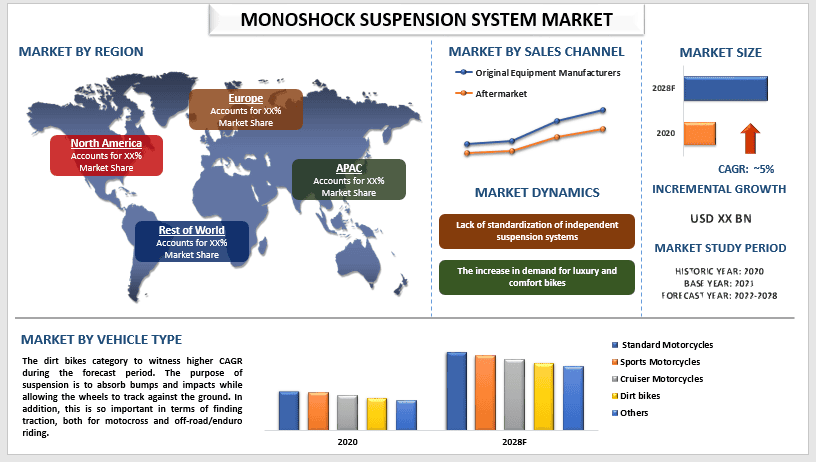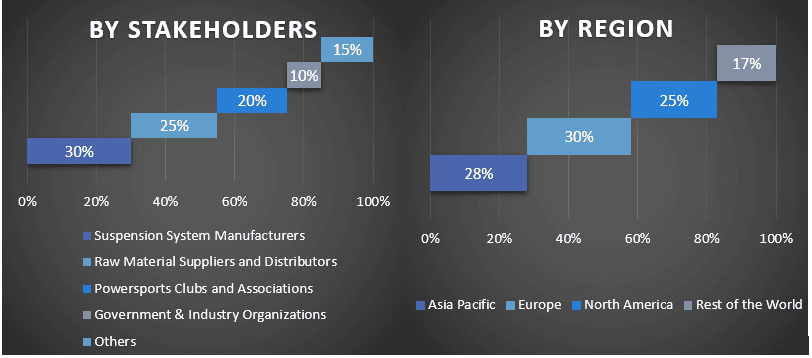- Home
- About Us
- Industry
- Services
- Reading
- Contact Us
Monoshock Suspension System Market: Current Analysis and Forecast (2022-2028)
Emphasis on Motorcycle Type (Standard Motorcycles, Sports Motorcycles, Cruiser Motorcycles, Dirt bikes, and Others); Sales Channel (Original Equipment Manufacturers (OEMs), and Aftermarket); and Region/Country

The Global Monoshock suspension system Market is expected to grow at a significant rate of around 5% during the forecast period. Motorcycles with mono-shock suspension systems employ this style of suspension to lessen the impacts of dampening and to improve rider comfort. Sports bikes, and dirt bikes both use mono-shock suspension systems to increase their performance. Due to its excellent stability during bike jumps and landings, monoshock suspension systems are often known as flying suspension. Moreover, the monoshock suspension system uses a single, or mono, absorber that is larger than a regular absorber and has a powerful spring attached to the outside. The motorcycle’s chassis and the rear swing arm of the rear wheel are often connected by a monoshock suspension system. For instance, Hero MotoCorp has launched the Hero Dirt Biking Challenge, an India-wide talent hunt for budding off-roading racers. It will hold qualifying rounds in 45 cities and up for grabs are some handy sponsorship contracts, as well as the chance to be trained by some of Hero Motorsports’ leading rally racers like Joaquim Rodrigues and CS Santosh.
Öhlins Racing AB, SKF, Nitron Racing Shocks, BMW AG, Hagon Products Ltd, Honda Motor Co., Ltd, Robert Bosch GmbH, Endurance Technologies Limited, TFX Suspension Technology, MH Suspension Ltd are some of the key players in the market. Several M&As along with partnerships have been undertaken by these players to facilitate customers with hi-tech and innovative products/technologies.
Insights Presented in the Report
“Amongst motorcycle type, dirt bikes category to witness robust CAGR during the forecast period”
Based on motorcycle type, the market is segmented into standard motorcycles, sports motorcycles, cruiser motorcycles, dirt bikes, and others. Dirt bikes category to witness higher CAGR during the forecast period. The purpose of suspension is to absorb bumps and impacts while allowing the wheels to track against the ground. In addition, this is so important in terms of finding traction, both for motocross and off-road/enduro riding. For instance, the U.S holds multiple racing events across the year where participants compete for titles and rewards. World Off-Road Championship Series (WORCS) is one of the biggest racing events organized in the country.
“Amongst sales channels, the aftermarket to hold a significant share in the market in 2020”
Based on the sales channel, the market is categorized into original equipment manufacturers (OEMs) and aftermarket. Among these, the OEMs to hold a significant share in the market in 2020. This is due to the motorcycle OEMs offering a variety of features, such as safety, stability, comfort, and performance, that are constantly evolving. The development of innovative electrical technology for motorcycles, such as the mono-shock suspension system that enhances handling and agility, is a focus of the industry.
“APAC to hold a significant share in the market”
In 2020, APAC to hold a significant share of the global mono-shock suspension system market. This is mainly attributed to the increasing recreational expenditure and the rising number of off-roading events driving the region’s suspension system market. Moreover, the growing preference of the youth toward adventure and off-road events and the availability of a wide range of products across varied prices are the factors that drive the growth of the industry. In addition, bikes with quality suspension are very useful in activities, such as hunting, nature exploration, hiking, and other outdoor exploration. Thus, growing participation in outdoor recreational activities has been a major driving factor in the market. Moreover, it is expected that the market will continue to grow at a steady rate during the forecast period owing to the high-income levels of the consumers in the region coupled with rising awareness about the importance of spending time in outdoor recreational activities for a balanced and healthy life.
Reasons to buy this report:
- The study includes market sizing and forecasting analysis validated by authenticated key industry experts.
- The report presents a quick review of overall industry performance at one glance.
- The report covers an in-depth analysis of prominent industry peers with a primary focus on key business financials, product portfolio, expansion strategies, and recent developments.
- Detailed examination of drivers, restraints, key trends, and opportunities prevailing in the industry.
- The study comprehensively covers the market across different segments.
- Deep dive regional level analysis of the industry.
Customization Options:
The global monoshock suspension system market can further be customized as per the requirement or any other market segment. Besides this, UMI understands that you may have your own business needs, hence feel free to connect with us to get a report that completely suits your requirements.
Table of Content
Research Methodology for the Monoshock Suspension System Market Analysis (2022-2028)
Analyzing the historical market, estimating the current market, and forecasting the future market of the global monoshock suspension system market were the three major steps undertaken to create and analyze the adoption of monoshock suspension system s in major regions globally. Exhaustive secondary research was conducted to collect the historical market numbers and estimate the current market size. Secondly, to validate these insights, numerous findings and assumptions were taken into consideration. Moreover, exhaustive primary interviews were also conducted, with industry experts across the value chain of the global monoshock suspension system market. Post assumption and validation of market numbers through primary interviews, we employed a top-down/bottom-up approach to forecasting the complete market size. Thereafter, market breakdown and data triangulation methods were adopted to estimate and analyze the market size of segments and sub-segments of the industry pertains to. Detailed methodology is explained below:
Analysis of Historical Market Size
Step 1: In-Depth Study of Secondary Sources:
Detail secondary study was conducted to obtain the historical market size of the monoshock suspension system market through company internal sources such as annual reports & financial statements, performance presentations, press releases, etc., and external sources including journals, news & articles, government publications, competitor publications, sector reports, third-party database, and other credible publications.
Step 2: Market Segmentation:
After obtaining the historical market size of the monoshock suspension system market, we conducted a detailed secondary analysis to gather historical market insights and share for different segments & sub-segments for major regions. Major segments are included in the report as motorcycle type and sales channel. Further country-level analyses were conducted to evaluate the overall adoption of testing models in that region.
Step 3: Factor Analysis:
After acquiring the historical market size of different segments and sub-segments, we conducted a detailed factor analysis to estimate the current market size of the monoshock suspension system market. Further, we conducted factor analysis using dependent and independent variables such as various motorcycle type and sales channel of monoshock suspension system s. A thorough analysis was conducted for demand and supply-side scenarios considering top partnerships, mergers and acquisitions, business expansion, and product launches in the monoshock suspension system market sector across the globe.
Current Market Size Estimate & Forecast
Current Market Sizing: Based on actionable insights from the above 3 steps, we arrived at the current market size, key players in the global monoshock suspension system market, and market shares of the segments. All the required percentage shares split, and market breakdowns were determined using the above-mentioned secondary approach and were verified through primary interviews.
Estimation & Forecasting: For market estimation and forecast, weights were assigned to different factors including drivers & trends, restraints, and opportunities available for the stakeholders. After analyzing these factors, relevant forecasting techniques i.e., the top-down/bottom-up approach were applied to arrive at the market forecast for 2028 for different segments and sub-segments across the major markets globally. The research methodology adopted to estimate the market size encompasses:
- The industry’s market size, in terms of revenue (USD) and the adoption rate of the monoshock suspension system market across the major markets domestically
- All percentage shares, splits, and breakdowns of market segments and sub-segments
- Key players in the global monoshock suspension system market in terms of products offered. Also, the growth strategies adopted by these players to compete in the fast-growing market
Market Size and Share Validation
Primary Research: In-depth interviews were conducted with the Key Opinion Leaders (KOLs) including Top Level Executives (CXO/VPs, Sales Head, Marketing Head, Operational Head, Regional Head, Country Head, etc.) across major regions. Primary research findings were then summarized, and statistical analysis was performed to prove the stated hypothesis. Inputs from primary research were consolidated with secondary findings, hence turning information into actionable insights.
Split of Primary Participants in Different Regions

Market Engineering
The data triangulation technique was employed to complete the overall market estimation and to arrive at precise statistical numbers for each segment and sub-segment of the global monoshock suspension system market. Data was split into several segments & sub-segments post studying various parameters and trends in the areas of type, drive type, and application in the global monoshock suspension system market.
The main objective of the Global Monoshock Suspension System Market Study
The current & future market trends of the global monoshock suspension system market was pinpointed in the study. Investors can gain strategic insights to base their discretion for investments on the qualitative and quantitative analysis performed in the study. Current and future market trends determined the overall attractiveness of the market at a regional level, providing a platform for the industrial participant to exploit the untapped market to benefit from a first-mover advantage. Other quantitative goals of the studies include:
- Analyze the current and forecast market size of the monoshock suspension system market in terms of value (USD). Also, analyze the current and forecast market size of different segments and sub-segments
- Segments in the study include areas of motorcycle type and sales channel.
- Define and analysis of the regulatory framework for the monoshock suspension system
- Analyze the value chain involved with the presence of various intermediaries, along with analyzing customer and competitor behaviors of the industry.
- Analyze the current and forecast market size of the monoshock suspension system market for the major region.
- Major countries of regions studied in the report include Asia Pacific, Europe, North America, and the Rest of the World.
- Company profiles of the monoshock suspension system market and the growth strategies adopted by the market players to sustain in the fast-growing market
- Deep dive regional level analysis of the industry
Related Reports
Customers who bought this item also bought










